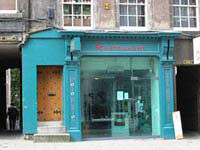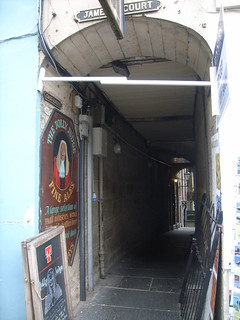Lawnmarket & bank Street
The Tolbooth Kirk and Assembly Hall mark the top of the Lawnmarket, a much broader street named after the old linen market which used to be held here.
At the northern end is Milne's Court, built in 1690 and skilfully renovated in 1971 as student residences. Next comes James Court, a very prestigious address, where the philosopher David Hume lived and where Boswell entertained Dr Johnson in 1773.
Back on the Lawnmarket itself, at number 477b, is Gladstone's Land, the most important surviving example of 17th-century tenement housing in the Old Town, where the cramped conditions meant that extension was only possible in depth or upwards. The magnificent six-storey building, completed in 1620, contains remarkable painted ceilings and was the home of an Edinburgh burgess, Thomas Gledstanes. The reconstructed shop booth on the ground floor has replicas of 17th-century goods and the first floor of the house has been refurbished as a typical Edinburgh home of the period. If you like what you see, then you can also stay here (see page ). _ 1 Apr-end-Oct Mon-Sat 1000-1700, Sun 1400-1700. £3.50, £2.50 concession. Tel: 2265856 (NTS).
Further down Lawnmarket, steps lead down to Lady Stair's Close, where you'll find Lady Stair's House, another fine 17th-century house, though restored in pseudo-medieval style. It is now the home of the Writer's Museum, dedicated to the three giants of Scottish literature, Burns, Scott and Stevenson. _ Mon-Sat 1000-1700 and Sun 1400-1700 during the Festival only. Free. Tel: 5294901.
Opposite Gladstone's Land is Riddle's Court, another of David Hume's residences. Here also is the late-16th-century house of Bailie McMorran, who was shot dead by pupils of the Royal High School during a riot in 1595 against the proposed reduction in school holidays. Further down the street on the same side is Brodie's Close, named after the father of one of Edinburgh's most nefarious characters, Deacon Brodie. He was an apparent pillar of the community by day and a burglar by night, until his eventual capture and hanging in 1788. Robert Louis Stevenson co-wrote a play about his life, which was to provide the inspiration for Dr Jeckyll and Mr Hyde.



